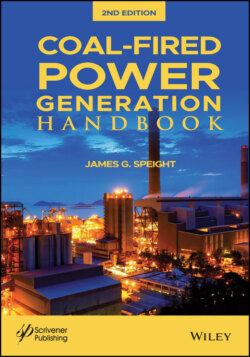Читать книгу Coal-Fired Power Generation Handbook - James Speight G., James G. Speight - Страница 74
3.6.1 Rotary Dryers
ОглавлениеThe rotary dryer is the most established dryer type and one of the most common for general applications. The basic design consists of an insulated cylindrical shell that is mounted on rollers and rotates at a low speed. Rotary dryers allow direct and/or indirect contact between the drying medium and the wet particles, although the former is more common in industry.
In the direct rotary dryers, the wet material is in direct contact with the drying medium. Direct heat transfer is usually provided by a hot gaseous medium blown into the vessel from the gas inlet. For drying of low-rank coal, the drying medium must be free of oxygen to prevent spontaneous ignition and combustion during storage (Chapter 4). Flue gases or heated air are the most common drying medium and in principal suitable for application to low-rank coal. However, there are reports of fires and explosions from oxygen contacting hot coals especially during start-up and shut down from such a system (Wilver and Brumbaugh, 1985). To avoid such accidents, one must ensure that the coal is sufficiently cooled before exposure to the environment.
Gas can flow in the direction of feed progression (parallel flow), or in the opposite direction (counter-flow). Although counter-current flow offers higher thermal efficiency, parallel flow prevents the overheating of the coal near the exit of the dryer.
Typically, an indirect rotary dryer consists of a jacketed shell through which steam or other heating medium flows. At any one time, a small fraction of solids are exposed to the heated wall, resulting in low heat transfer rates and low drying efficiency. One way to improve the performance of an indirect dryer is to increase the area of contact between the heated wall and the particles. This is accomplished by introducing a series of tubes through the rotary shell and passing steam through the tubes. In the steam-tube dryer, wet solids are lifted and showered within the rotary shell in the usual sense, and heated by radiant heat and contact with the outer surfaces of the tubes.
Rotary dryers designed for continuous processing are usually slightly inclined so that as the main vessel rotates, feed material progresses from the higher end of the vessel to its lower end. In such a system, the particles are conveyed by repetitive lifting and falling action provided by the circumferentially mounted flights and the force of gravity. The periodic lifting and showering of the material creates a curtain of particles through which hot gas flows. This agitation leads to higher efficiencies, increased heat transfer rate, and reduced processing time compared to stationary units. Thus, feed material is heated and dried as it progresses through the dryer.
